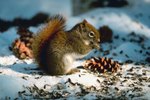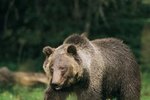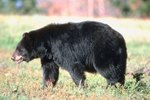
During the harsh winter months, many animals have adapted a special way of surviving the frigid temperatures: hibernation. Animal that hibernate have a unique way of slowing down their body functions so they can essentially “sleep” away the winter months.
American Black Bear
It’s no secret that bears hibernate during the winter. American black bears are hibernating champs, able to bed down for as long as 100 days. During this time the bear goes without eating, drinking, exercise or bathroom breaks. During the summer, American black bears begin preparations for winter. They pack on as much as 30 pounds a week, gobbling up berries and other carb-rich foods. By the time fall rolls around, the fattened up bears begin building nests out of leaves and twigs in their dens. When winter comes, the bear rolls into a tight ball, tucking his head between his paws and turning his back to the frigid cold. During the deepest hibernation, the bear’s heart slows to only eight beats a minute, getting all the water and calories he needs by breaking down stored fat. As the temperature rises in the spring, the bear will wake up from his long hibernation, no worse for wear.
Arctic Ground Squirrel
The arctic ground squirrel hibernates in Alaska, Canada and Siberia to survive the unforgiving winter months. Starting in September, the ground squirrels burrow into the ground and will stay there until late April. What makes ground squirrels unique is their ability to supercool, meaning their body temperature drops below the freezing point of water. They hold the record for the lowest body temperature ever recorded in an animal. Every two or three weeks during hibernation, the squirrels with shiver for up to 15 hours to warm them up to their normal body temperature before their temperature plummets again. Despite their freezing temperatures, ground squirrels come out of hibernation perfectly healthy.
Hedgehogs
There are only three animals that hibernate during the British winters: bats, dormice and hedgehogs. The hedgehog builds a nest where he will curl into a ball and appear dead during the coldest two or three months of winter. Brain activity slows to bare minimum, and his heart rate drops from almost 200 beats a minute to only 20. A breath every few minutes is all the hedgehog needs during hibernation. He’ll live off the fat reserves he built up during late fall and early winter. He wakes up one-third smaller than he was when he went into hibernation and extremely thirsty when the weather warms and his fat reserves run low.
Garter Snakes
Garter snakes hibernate a little differently than mammals do, called brumation. They don’t store up fat reserves. The cooler temperatures cause the garter snake’s metabolism to slow down to the point where he doesn’t need to eat. Over the course of the winter they won’t eat for months. They stop eating several weeks prior to hibernation to prepare and make sure their stomachs are empty. They hide below the frost line, and become extremely sluggish, possibly not moving at all, until temperatures rise enough for them to venture out and eat again.
References
Photo Credits
-
Jupiterimages/Photos.com/Getty Images




